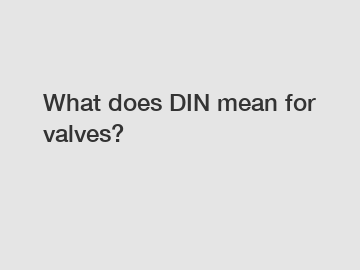What does DIN mean for valves?
DIN stands for Deutsches Institut für Normung, which translates to German Institute for Standardization. It is a standardization organization in Germany that sets quality standards for various industries, including the valve industry.
The origins of DIN can be traced back to the early 20th century when the need for standardization arose in Germany. At that time, different regions in Germany had their own standards, which created inefficiencies and hindered trade. To overcome these challenges, the German industry came together to establish a unified standardization system.

DIN standards are developed through a rigorous process that involves experts from relevant industries, scientific research institutions, and government representatives. These experts collaborate to define technical specifications, performance requirements, and testing methods for various products, including valves.
The DIN standard for valves covers a wide range of specifications, such as design, dimensions, materials, and testing procedures. By adhering to these standards, manufacturers ensure that their valves meet specific criteria for quality, reliability, and safety.
The importance of DIN standards for valves is manifold. Firstly, they enable interoperability and interchangeability between different valve components, allowing for easier maintenance and replacement. This is particularly crucial in industries where valves are widely used, such as oil and gas, chemical, and manufacturing.
Secondly, DIN standards ensure a level playing field for manufacturers. By establishing clear guidelines, the standards prevent unfair competition based on inferior product quality or unsafe designs. This fosters healthy competition and encourages innovation in the valve industry.
Moreover, DIN standards improve efficiency and reduce costs. When valves are manufactured according to standardized specifications, it becomes easier to integrate them into larger systems and processes. This not only saves time but also minimizes potential errors and reduces the need for customization.
From a global perspective, DIN standards are widely recognized and adopted. They provide a common framework for valve manufacturers, buyers, and users across different countries. This global acceptance facilitates international trade and contributes to the harmonization of quality standards worldwide.
In conclusion, DIN, meaning Deutsches Institut für Normung, plays a crucial role in defining standards for valves. The organization's dedication to quality, reliability, and safety has resulted in a comprehensive set of specifications that benefits manufacturers and users alike. By adhering to DIN standards, valve manufacturers ensure their products are of high quality, compatible with existing systems, and meet the requirements of an increasingly interconnected world.
If you want to learn more, please visit our website china nrs gate valve, buy non rising stem ductile iron gate valve, non rising stem ductile iron gate valve price.



Comments
Please Join Us to post.
0